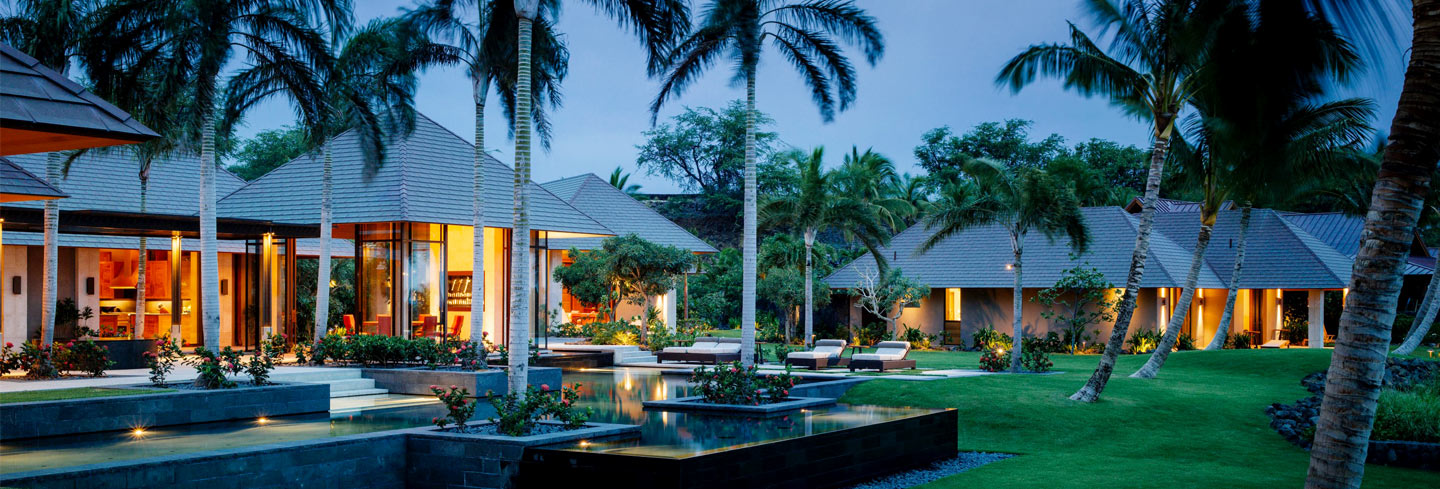
Kauhale Kai By de Reus Architects
Text by Intan Kalih, Photography courtesy of de Reus Architects.
Thursday 23 June 2016
Hawaii’s well-concocted blend of modernity, tradition, and warmth was aptly captured in this tropical style dwelling in the southern coast of Kohala Beach, creating an architecture that is in harmony with the surrounding nature.

Good design is respectful of tradition while being evolutionary and adaptive. This particular statement was made by Mark de Reus, Principal of de Reus Architects, an established architecture company credited with designing various world-renowned resorts around the globe. His ability to combine architecture, interior, as well as landscape, into a united form of both modern and traditional concepts, has gained worldwide recognition. The Kauhale Kai at Kohala Beach, Hawaii, is one such concrete proof.
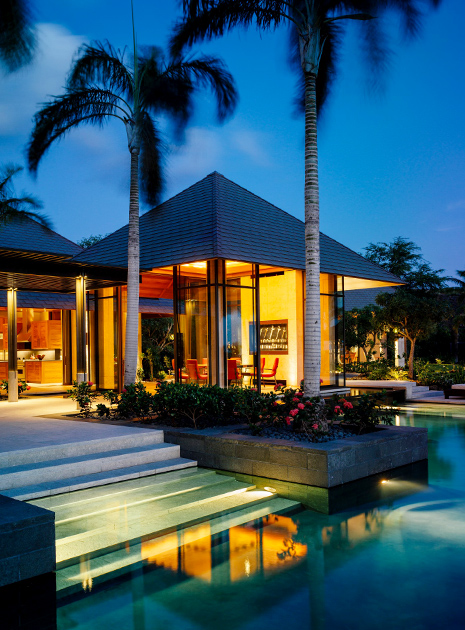
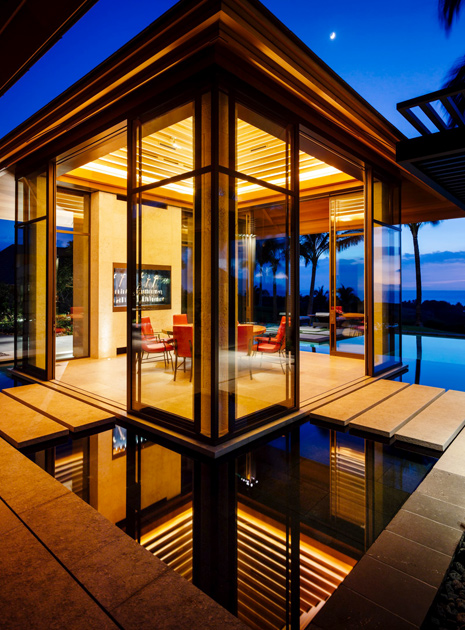
Having received the Award of Excellence AIA Honolulu Design Awards, this residential perfectly illustrates Mark de Reus’ vision for a modern reinterpretation of the typical Pacific traditional architecture.

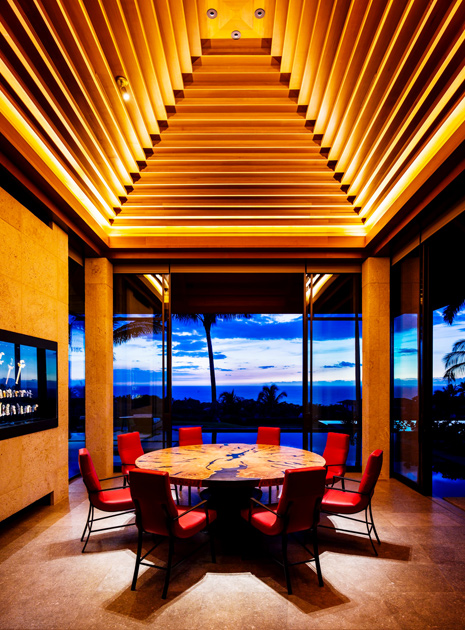
Built in a spacious area of 6700m2 wide, Kauhale Kai consists of seven separate pavilions. “All the pavilions were arranged for their purpose for living on this property and being integrated with the water elements: the ocean beyond, the reflecting pools and the swimming pool,” says Mark. The layout starts on the main outdoor pavilion located at the best spot, or can also be referred to as the “sweet spot” in the house to admire the scenery, sheltered from the wind. Furthermore, there are three pavilions serving as bedrooms are scattered at various corners of the house. “The swimming pool and its formal geometry is the organizational element around which the house unfolds. The spaces in between the buildings were also carefully crafted along with the buildings,” says Mark who had previously lived and worked in Indonesia.

Overall, Kauhale Kai resembles a small village in perfect synergy with the surrounding nature. “Our design focus wanted to be respectful of the site, the community, the Polynesian and Hawaiian setting and island cultures; in straddling modern and traditional, we felt we would find a timeless quality,” adds Mark.

He admits, there are a lot of subtle things during the planning and designing process that can bring cultural aspects onto the atmosphere of this house. It all started at the early stage, when the building and location were set, without the need to involve cliché decorations. The design itself evolved from being a cultural reference into a layer for the building, as well as open spaces and landscapes. “For instance with the architectural water features of this home: the large stacked basalt stone fountain wall upon entry to the home was inspired from the Micronesian island of Nan Madol; the circular stone “well-spring” fountain at the axis mundi or “spiritual center” of the home, the stepped ceilings of the outdoor and dining pavilions are a direct reference to the ancient Majapahit artistic sensibilities,” explains Mark de Reus who is also the writer of Tropical Experience: Architecture + Design book, “ The water features are architectural and act as an organizing armature for the main gathering spaces of the home – while modern in expression the integrated water elements make a nod to the ancient baths of Bali. The key to incorporating cultural references or cues is to avoid the cliché, or a decorative pastiche.”
 Mark de Reus
Mark de Reus
The owner, who has an interest in art, also contributes to a different atmosphere through the installation of modern artworks. Not to forget, he also collects many decorative elements from various parts around the world, such as a keris collection and doors from Bali.

To quote Mark – who has made the World’s Top Architects and Designers Architectural Digest 100 List, there are formal and informal aspects in the design that are essential to the planning stage of the house: more aesthetical function and aspect to meet the standards of living or livability of the house. This particular part was of the utmost importance to Mark and his team, in order to bring the soul of Kauhale Kai to life.
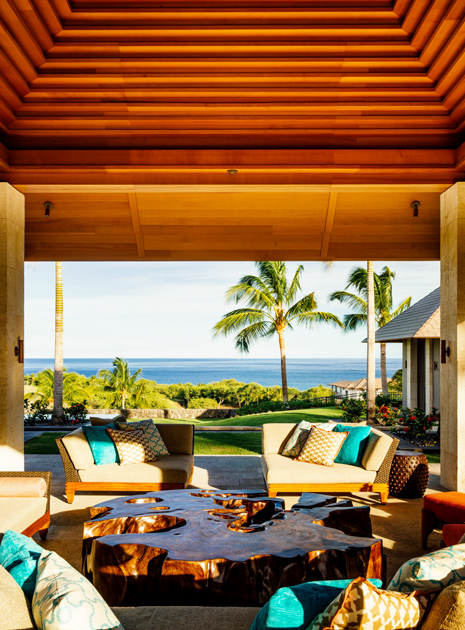
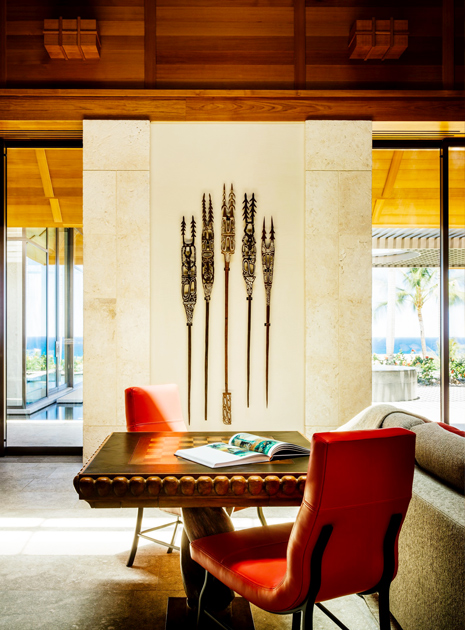
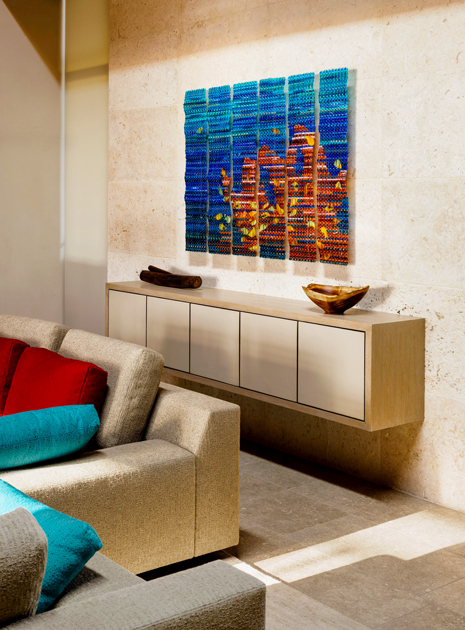
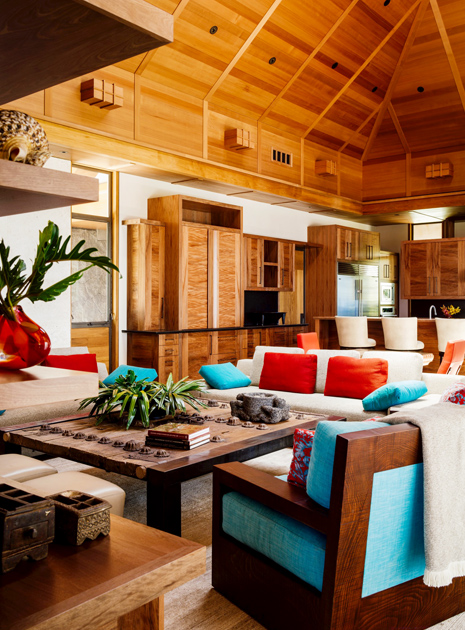
Additional Information
Location: Island of Hawaii, USA
Land Area: 3,013 SF; 8,641 SM
Building area: 6,674 SF; 620 SM
Architect: de Reus Architects
Interior Designer: Jacques St. Dizier
Lighting Designer: KGM
Landscape Designer: David Tamura Landscape Architecture

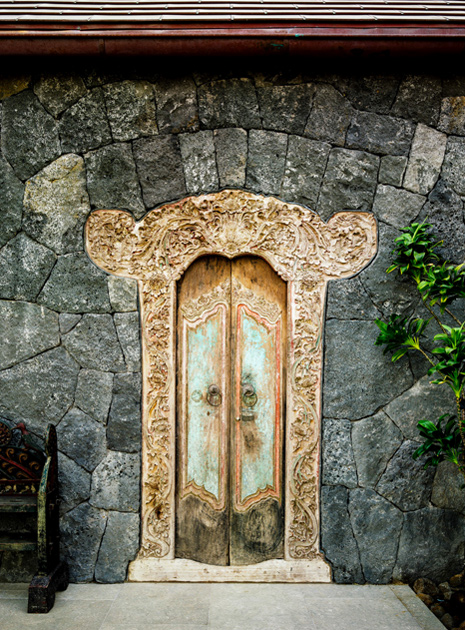
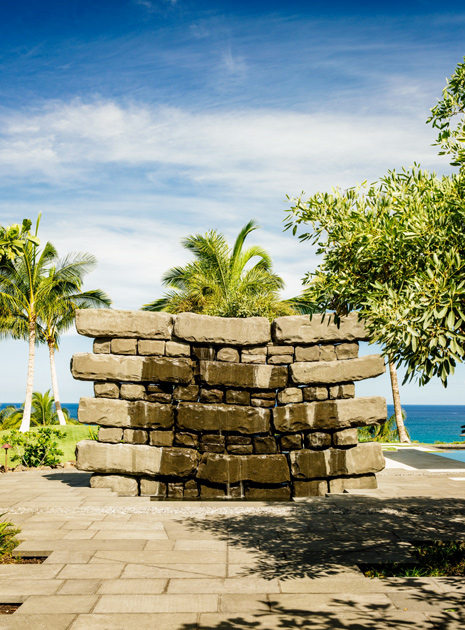

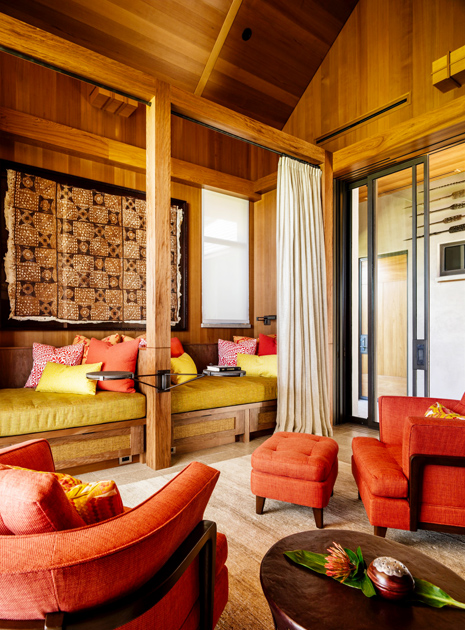
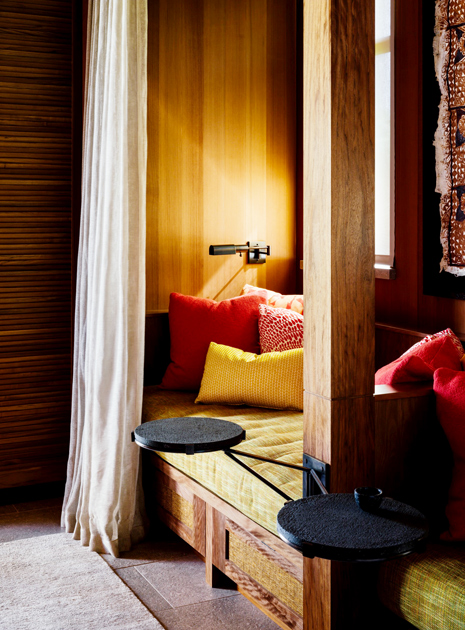
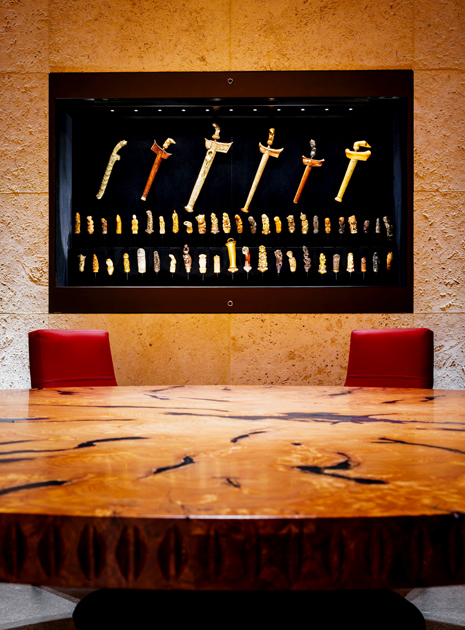
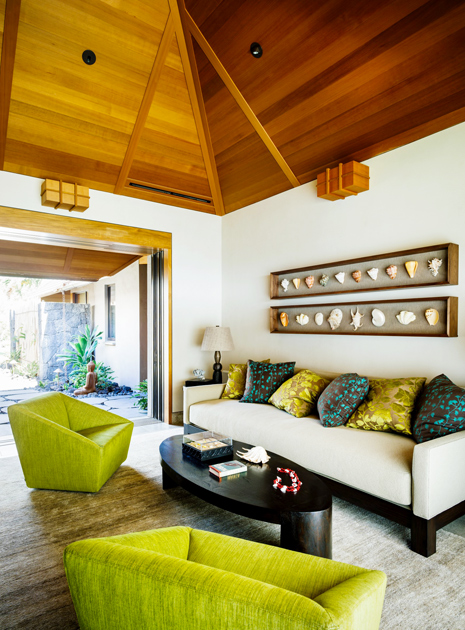

Modernitas, tradisi, dan kehangatan Hawaii tertangkap baik dalam hunian bergaya tropis di wilayah selatan pantai Kohala. Menciptakan arsitektur yang selaras dengan alamnya.

Desain yang baik pasti memiliki rasa hormat pada tradisi, namun sekaligus bersifat evolusioner dan adaptif. Sepenggal kalimat ini diutarakan Mark de Reus, principal de Reus Architects yang banyak dipercaya mendesain sejumlah resort ternama dunia. Kemampuannya memadukan arsitektur, interior, juga lanskap dalam kesatuan konsep modern dan tradisional telah mendapat pengakuan. Kauhale Kai di pantai Kohala, Hawaii, menjadi salah satu bukti.


Hunian yang dinobati Award of Excellence AIA Honolulu Design Awards ini menggambarkan visi Mark de Reus untuk memberikan reinterpretasi modern akan arsitektur tradisional khas pasifik.


Dalam luas area 6700m2, Kauhale Kai terdiri atas tujuh pavilion yang terpisah. “Semua pavilion ditata sesuai dengan fungsinya di hunian ini dan secara keseluruhan terintegrasi oleh elemen air: laut lepas, kolam, dan kolam renang,” ujar Mark. Layout dimulai dari pavilion outdoor utama yang berlokasi di titik terbaik atau bisa disebut sebagai “sweet-spot” dalam hunian untuk melihat pemandangan dan letaknya terlindungi dari angin pantai. Selanjutnya, tiga pavilion yang berfungsi sebagai kamar tidur tersebar di sudut hunian. “Kolam renang dengan bentuk geometris menjadi elemen yang menghubungkan keseluruhan tata bangunan. Di samping ruang-ruang terbuka yang secara teliti dibentuk mengitari bangunan,” arsitek yang pernah tinggal dan bekerja di Indonesia ini kembali menjelaskan.

Secara keseluruhan Kauhale Kai menyerupai desa kecil yang bersinergi dengan alam terbuka. “Fokus desain kami adalah bagaimana menghormati lingkungan setempat, komunitas, kekhasan kultur Polynesia dan Hawaii; dengan menjembatani modern dan tradisional, kami merasa bisa mendapatkan kualitas yang tak lekang dimakan waktu,” tambah Mark .

Diakuinya, ada banyak hal subtil dalam perencanaan dan proses desain ruang yang dapat memunculkan aspek kultural ke dalam atmosfer hunian. Semuanya dimulai sejak tahapan awal saat bangunan dan lokasi dipertemukan, tanpa perlu melibatkan dekorasi yang klise. Desain tersebut berkembang dari referensi kultural menjadi layer bagi bangunan, juga ruang terbuka dan lanskap. “Contohnya arsitektur air yang ada di rumah ini; dinding air mancur terbuat dari batu basal yang ada di pintu masuk terinspirasi dari pulau Micronesia, Nan Madol. Air terjun berbentuk batu bulat sebagai ‘pusat spiritualitas’ hunian, lalu ceiling kayu bertingkat yang ada di area terbuka dan pavilion area makan diadaptasi dari kerajaan Majapahit kuno,” terang penulis buku Tropical Experience: Architecture + Design ini, “Fitur air bersifat arsitektural dan berfungsi sebagai bagian sakral yang menghubungkan ruang-ruang dalam kesatuan hunian. Sementara ekspresi modern pada elemen air yang terintegrasi tersebut mengingatkan pada tempat permandian kuno di Bali.”
 Mark de Reus
Mark de Reus
Pemilik hunian yang memiliki ketertarikan pada seni turut menyumbang atmosfer berbeda lewat pemasangan karya-karya seni modern. Tanpa melupakan bahwa ia pun mengumpulkan banyak elemen dekoratif yang bersumber dari berbagai penjuru, seperti koleksi keris dan pintu dari Bali.

Mengutip pendapat Mark—seorang yang masuk dalam World’s Top Architects and Designers Architectural Digest 100 List, ada aspek desain informal dan formal yang dibutuhkan dalam perencanaan hunian, yakni fungsi dan aspek estetis yang lebih banyak untuk memenuhi kenyamanan hidup atau livability dari rumah tersebut. Sisi ini tampaknya diperhatikan betul oleh Mark dan timnya untuk memunculkan jiwa dari Kauhale Kai.




Additional Information
Location: Island of Hawaii, USA
Land Area: 3,013 SF; 8,641 SM
Building area: 6,674 SF; 620 SM
Architect: de Reus Architects
Interior Designer: Jacques St. Dizier
Lighting Designer: KGM
Landscape Designer: David Tamura Landscape Architecture















